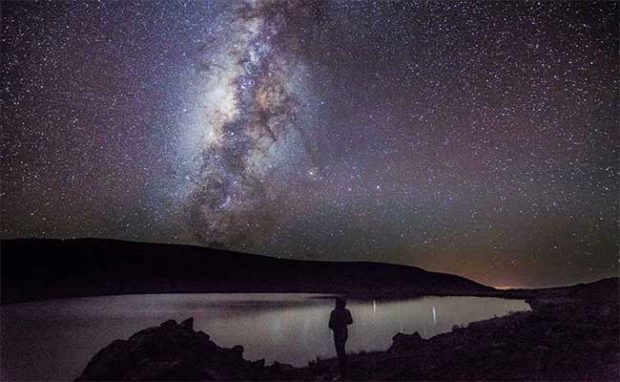Scientists Reveal First Image Ever of a Black Hole
Black Hole
The picture, assembled from data gathered by eight radio telescopes around the world, shows the hot, shadowy lip of a supermassive black hole, one of the light-sucking monsters of the universe theorized by Einstein more than a century ago and confirmed by observations for decades. It is along this edge that light bends around itself in a cosmic funhouse effect.
“We have seen what we thought was unseeable. We have seen and taken a picture of a black hole,” Sheperd Doeleman of Harvard, leader of a team of about 200 scientists from 20 countries, announced as the colorized orange-and-black picture was unveiled.
University of Waterloo physicist Avery Broderick, a co-discoverer, declared: “Science fiction has become science fact.”
In a historic feat by @EHTelescope & @NSF, a black hole image has been captured for the 1st time. Several of our missions observed the same black hole using different light wavelengths and collected data to understand the black hole's environment. Details: https://t.co/WOjLdY76ve pic.twitter.com/4PhH1bfHxc
— NASA (@NASA) April 10, 2019
In fact, Jessica Dempsey, a co-discoverer and deputy director of the East Asian Observatory in Hawaii, said the fiery circle reminded her of the flaming Eye of Sauron from the “Lord of the Rings” trilogy.
Unlike smaller black holes that come from collapsed stars, supermassive black holes are mysterious in origin. Situated at the center of most galaxies, including ours, they are so dense that nothing, not even light, can escape their gravitational pull. This one’s “event horizon” — the precipice, or point of no return, where light and matter begin to fall inexorably into the hole — is as big as our entire solar system.
Three years ago, scientists using an extraordinarily sensitive observing system heard the sound of two much smaller black holes merging to create a gravitational wave, as Albert Einstein predicted. The new image, published in the Astrophysical Journal Letters and announced around the world, adds light to that sound.
What it Means
Outside scientists suggested the achievement could be worthy of a Nobel Prize, just like the gravitational wave discovery.
“I think it looks very convincing,” said Andrea Ghez, director of the UCLA Galactic Center Group, who wasn’t part of the discovery team.
The image helps confirm Einstein’s general theory of relativity. Einstein a century ago even predicted the symmetrical shape that scientists just found.

Photo: Brett A. McGuire
The picture was made with equipment that detects wavelengths that can’t be seen by the human eye, so astronomers added color to convey the ferocious heat of the gas and dust, glowing at a temperature of perhaps millions of degrees. But if a person were to somehow get close to this black hole, it might not look quite like that, astronomers said.
The black hole is about 6 billion times the mass of our sun and is in a galaxy called M87 that is about 53 million light years from Earth. One light year is 5.9 trillion miles, or 9.5 trillion kilometers.
Black holes are the “most extreme environment in the known universe,” Broderick said, a violent, churning place of “gravity run amok.”
While much of the matter around a black hole gets sucked into the vortex, never to be seen again, the new picture captures gas and dust that are lucky to be circling just far enough to be safe and to be seen millions of years later on Earth.
A black hole’s gravity creates a funhouse effect where you can see light from both behind the black hole and behind you as the light curves and circles around the black hole.
Despite decades of study, there are a few people who deny black holes exist, and this work shows that they do, said Boston University astronomer professor Alan Marscher, a co-discoverer.
The project cost $50 million to $60 million, with $28 million of that coming from the National Science Foundation. The same team has gathered even more data on a black hole in the center of our galaxy, but scientists said the object is so jumpy they don’t have a good picture yet.
Myth says a black hole would rip you apart, but scientists said that because of the particular forces exerted by an object as big as the one they documented, someone could fall into it and not be torn to pieces. But the person would never be heard from or seen again.
Related Articles
After the Moon in 2024, NASA Wants to Reach Mars by 2033
SpaceX Capsule Back on Earth, Paves Way for New Manned US Flights
Black holes are “like the walls of a prison. Once you cross it, you will never be able to get out and you will never be able to communicate,” said astronomer Avi Loeb, who is director of the Black Hole Initiative at Harvard but was not involved in the discovery.
The telescope data was gathered two years ago, over four days when the weather had to be just right all around the world. Completing the image was an enormous undertaking, involving an international team of scientists, supercomputers and hundreds of terabytes of data.
When scientists initially put all that data into the first picture, what they saw looked so much like what they expected they didn’t believe it at first.
“We’ve been hunting this for a long time,” Dempsey said. “We’ve been getting closer and closer with better technology.”

